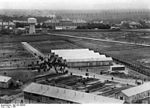Pithiviers
Communes of LoiretLoiret geography stubsOrléanaisPages including recorded pronunciationsPages with French IPA ... and 1 more
Subprefectures in France

Pithiviers (French pronunciation: [pitivje] ) is a commune in the Loiret department, north central France. It is one of the subprefectures of Loiret. It is twinned with Ashby-de-la-Zouch in Leicestershire, England and Burglengenfeld in Bavaria, Germany. Its attractions include a cinema, a theatre and a preserved steam railway.During World War II, Pithiviers was the location of the infamous Pithiviers internment camp. The pithivier, a kind of pie, is said to originate here in the middle ages. The traditional Pithivier was a small scalloped-edge sweet tartlet. Savoury versions can be filled with peacock, heron, swan or pork.
Excerpt from the Wikipedia article Pithiviers (License: CC BY-SA 3.0, Authors, Images).Pithiviers
Avenue de la République, Pithiviers
Geographical coordinates (GPS) Address Nearby Places Show on map
Geographical coordinates (GPS)
| Latitude | Longitude |
|---|---|
| N 48.1725 ° | E 2.2525 ° |
Address
Avenue de la République 2
45300 Pithiviers
Centre-Val de Loire, France
Open on Google Maps






